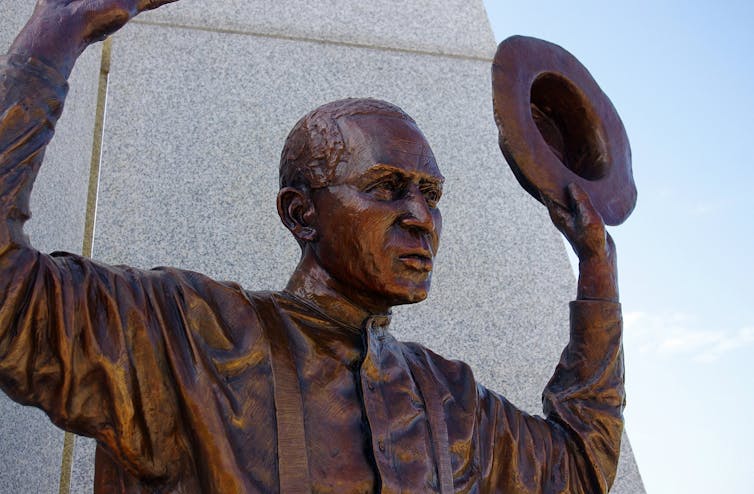
Russell Cobb, University of Alberta
The governor orders the National Guard to string barbed wire around the capitol building and take up defensive positions with machine guns.
The Ku Klux Klan, after a campaign of terror against the governor’s supporters, calls for his ouster. The governor promises to pardon anyone who shoots a klansman.
The KKK taunts the governor in the press, and headlines tell citizens to prepare for war.
No, this is not some The Plot Against America-style alternative history on Netflix. It is the scene-setting for an actual coup d’etat in the American heartland in the 1920s.
Nearly a century later, the media are reporting that Donald Trump’s continuing and ongoing threats to a peaceful transition of power are unprecedented in American history. The Washington Post editorial board remarked that when Americans see defeated political factions take up arms or send opponents to jail, a common response is, “this can happen in Zimbabwe … or Russia, or Cambodia, but not here. Not in the United States.”
But Americans don’t have to look overseas for antecedents of political coups. They can look at the Oklahoma State Capitol in 1923. What took place there fits the dictionary definition of a coup d’etat:
“A sudden, decisive exercise of force in politics.”
And it is almost entirely forgotten, with historical documentation filed away in an undigitized archive at the University of Oklahoma. For this detailed historical account, much of it based on 1920s news coverage, C. Blue Clark, a historian, and legal scholar, uncovered the Klan’s role in what had been remembered as a simple case of corruption.
He wrote in the preface to his 1976 dissertation:
“Enter a room filled with people and inquire about the Klan and the result is similar to turning on a light at night in a kitchen and watching cockroaches scatter.”
Echoes of 2020 unrest
The Klan’s overthrow of a governor is worth recalling, in part, because the 1922 Oklahoma election echoed many divisions of 2020.
The Democrat, Jack C. Walton, had his own version of the centrist versus progressive split in the party. Like President-elect Joe Biden, Walton stitched together a coalition of leftists, centrists, and people of colour. The Socialist Party had been surprisingly strong in Oklahoma during the 1910s but had never achieved real power. The remnants of that party-backed Walton.
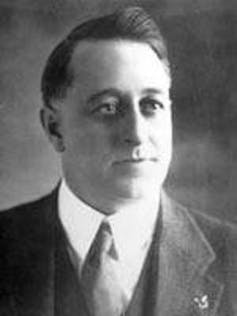 Jack C. Walton. (Creative Commons), CC BY
Jack C. Walton. (Creative Commons), CC BYDuring the campaign, Walton denounced the lynching of an African American man named Jake Brooks in Oklahoma City, while the Republican quietly accepted the endorsement of the Ku Klux Klan.
Moderate white voters in the cities of Tulsa and Oklahoma City were slow to perceive the insidious influence of the KKK in the political mainstream. But the Tulsa Race Massacre of 1921 had proven the organization was not the “benevolent society” of its propaganda.
Read more:
Trump rally in Tulsa, a day after Juneteenth, awakens memories of 1921 racist massacre
When the KKK built a massive convention building called Beno Hall on Tulsa’s Main Street, the organization marketed “Beno” as short for “benevolent.” But everyone knew it meant “be no immigrants, be no Jews, be no [n-word].”
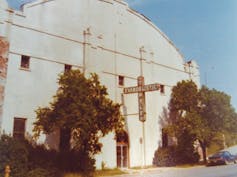 The cavernous white building built by the Klan, seen here in the 1970s, later served as an evangelical church.
The cavernous white building built by the Klan, seen here in the 1970s, later served as an evangelical church.(Creative Commons), CC BY
The new Oklahoma Grand Dragon was a pharmaceutical salesman from Oklahoma City named N.C. Jewett. He went on a public relations campaign to assure anxious moderates that the KKK’s aim was to help maintain law and order.
“A person could not drive on the roads outside Tulsa without being hijacked,” Jewett told the press.
The Klan promised to fix all that.
A terrorism campaign
In reality, the KKK conducted a campaign of terrorism backed by police and city officials. Lynchings were the most notorious acts, but more common — even every day — occurrences were whippings, beatings, and death threats. Police often stood by as the Klan carried out activities, and its intimidating behavior inspired copycats, including one group who kidnapped a Black police officer and cut off his ear.
After winning a decisive election against the Republican, Gov. Walton sought to suppress the KKK, but with little luck. In Tulsa, a Jewish man suspected of dealing narcotics was kidnapped and beaten. Walton read that the man’s penis was flayed open and he was near death in hospital. The governor demanded accountability but was met with silence from local investigators.
Walton had toyed with Klan support during his campaign, but now he was ready for total war. “There cannot be two governments in Oklahoma while I am governor,” he declared to the press. Everyone responsible for the Klan’s terror would face justice. He deployed the National Guard to find Klansmen and set up military tribunals to try them.
Jewett shot back in the KKK-sympathetic dailies:
“Jack Walton and all his cohorts will never be able to break the power of the Klan in Oklahoma.”
A military tribunal in Tulsa revealed just how deeply the Klan had infiltrated the city’s power structure. Seemingly every elected official in the city was a Klan member; one historian estimated that a majority of the elected legislators were Klansmen. Walton declared martial law in Tulsa and sent a censor to muzzle the Tulsa Tribune’s Klan-sympathetic editor, Richard Lloyd Jones.
Walton impeached
Legislators started impeachment proceedings against Walton for abuse of power.
By sending out the troops, censoring the press, and declaring martial law, the governor lost support from former backers who hated the Klan but feared the state was descending into a dictatorship. The governor ordered the legislature to disperse and said that “the troops will be ordered to shoot to kill if that is necessary to prevent the assembly.”
Fistfights broke out among legislators as barbed wire and machine guns appeared at the capitol. Legislators took up impeachment hearings at Oklahoma City’s swanky Skirvin Hotel. Walton was ultimately impeached and removed from office.
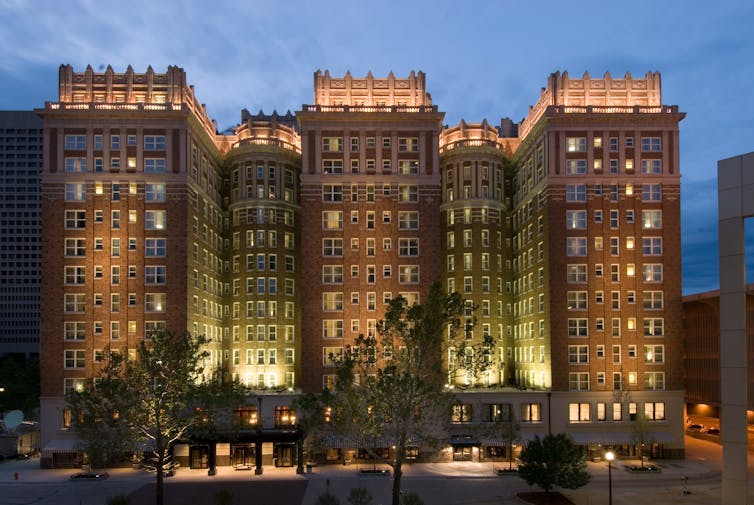 Oklahoma City’s Skirvin Hotel, now the Skirvin Hilton Hotel, today. Impeachment hearings against Walton were held here.
Oklahoma City’s Skirvin Hotel, now the Skirvin Hilton Hotel, today. Impeachment hearings against Walton were held here.(Skirvin Hilton Hotel)
Less than a year later, a special train car of Oklahoma Klansmen pulled into Dallas for the Texas State Fair. A banner on the car read: “Did We Impeach Walton? Hell Yes.”
This episode is misremembered as a tale of corruption in the state’s highest office. Three governors were impeached between 1910 and 1930, and if Walton is remembered at all, it is for misusing the National Guard. As with the Tulsa Race Massacre of 1921, the white establishment of the state wanted this episode forgotten.
No aberration
The Klan’s overthrow of Walton is a pointed reminder that white nationalists once wielded raw power in American politics. It is also not an aberration. In 1898, white nationalists in Wilmington, N.C., massacred the city’s Black population and overthrew its newly elected mayor.
We downplay seemingly ridiculous white nationalist groups like the Boogaloo Boys at our peril. And rhetoric about the exceptionalism of American democracy is neither helpful nor accurate.
There is, however, one hopeful note in this story of a forgotten coup in the American heartland.
By 1925, even the white populace of Oklahoma had seen enough. Anti-Klan movements in small towns sprung up as self-defensive leagues (Antifa in rural America!). Voters tired of a secret society choosing candidates in Beno Hall and beating up anyone who strayed from the Klan’s white fundamentalist world view. Membership declined and masked crusaders became the object of scorn in popular media.
If only our story ended there.![]()
Russell Cobb, Associate Professor of Latin American Studies, University of Alberta
This article is republished from The Conversation under a Creative Commons license. Read the original article.

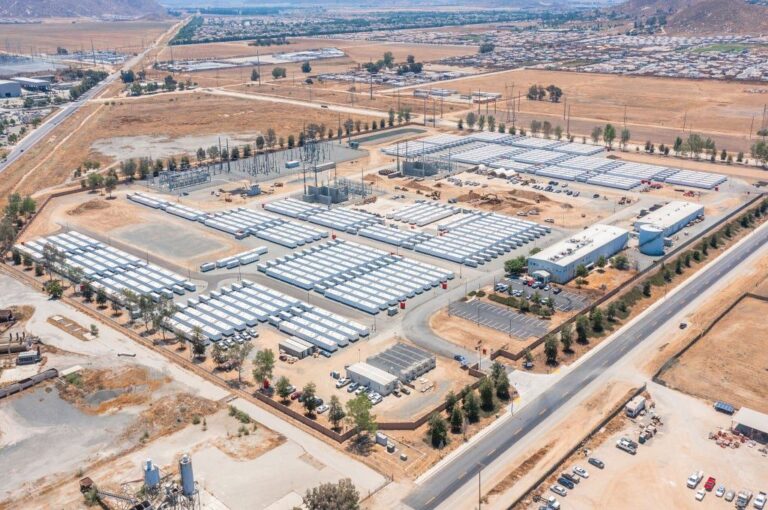


11 Comments
Pingback: เว็บมวยราคาดีที่สุด
Pingback: รวมเว็บพนันออนไลน์
Pingback: Fake site and will take your money! Beware of uplinke.com Spam and make your site go down. Too good to be true SCAM
Pingback: slot gacor
Pingback: ลวดสลิง
Pingback: https://stealthex.io
Pingback: alternatif dultogel
Pingback: สมัคร LSM99 โบนัสแตกถอนได้ไม่อั้น
Pingback: once human game cheats
Pingback: lottorich28
Pingback: 711GAME